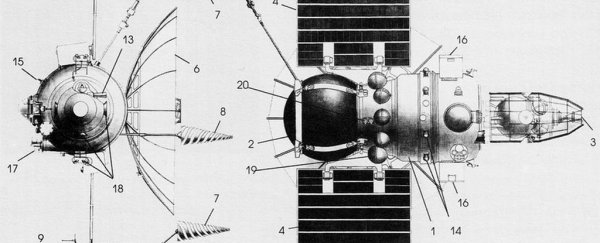There's a lot of junk in Earth's orbit we don't tend to see in our skies; a lot of that space debris is pretty small, but there are some bigger pieces. As they lose altitude, we can expect to see them again - and one could be coming rather soon.
That piece of junk is Kosmos 482, a Soviet space probe launched on 31 March 1972. It was bound for Venus, but when it tried to depart Earth orbit, the probe unfortunately broke into pieces, and never made it out.
Some of the craft fell back to Earth within a month of its launch. But a large chunk is still up there, including the 495-kilogram (1,091-pound) descent craft. It was expected to fall sometime between 2023 and 2025, but it could be much sooner - as early as this year, according to a new report on Space.com.
The piece's descent has been steady for years. The booster failure that saw part of the spacecraft fall unceremoniously back to Earth actually flung the rest of the spacecraft higher into low-Earth orbit, but its downward trajectory was still inevitable.
It's worth noting that the piece is on an elliptical orbit, swooping out as far as 2,409.4 kilometres (1,497.1 miles) and in as close as 209.7 kilometres (130.3 miles). Currently, its mean altitude is 1,309.6 kilometres (813.7 miles) - down from around 1,367 kilometres (849 miles) this time last year.
At the moment, its breakneck speed gives the chunk enough momentum to stay in orbit. But as that orbit decays, its descent is expected to accelerate as the pull of Earth's gravity grows stronger.
And, because the descent craft was built to withstand a touchdown on Venus in the hellishly hot temperatures of the planet's surface (for a little while, anyway), it's expected that it will make it back to Earth in one piece.
"Yes, the descent craft will survive a re-entry with no problems," satellite watcher Thomas Dorman told Space.com. "It would be funny if it was spotted coming down and the parachute has deployed … but I am sure the batteries to fire the pyrotechnics to release the parachute have died long ago!"
We know that it can survive re-entry, because Kosmos 482 had a sister craft, Venera 8, launched four days earlier. (Kosmos is a generic designation the Soviet Union gave to a series of items in Earth's orbit; had Kosmos 482 made it to Venus, it would have ended up with a different name.)
Venera 8 actually made a successful descent to the surface of Venus, where the mean temperature is around 462 degrees Celsius (864 degrees Fahrenheit). Once there, it did something even more amazing: it survived, transmitting data, for over 50 minutes.
So Kosmos 482's descent craft might break apart on impact, but we'd be betting that it will make it to that point relatively unscathed. Although, as Dorman observed, it may have some of the upper spacecraft bus still attached. In his observations of the spacecraft, he saw flares of light, which wouldn't be produced just by the spherical lander.
"Our guess is maybe as much as 40 to 50 percent of the upper spacecraft bus may still be there," he said.
He predicted that it would fall to Earth late this year or sometime next year.
So, do you need to worry? Well, it's hard to tell, although danger seems unlikely. Most space debris - like Chinese satellite Tiangong-1, which descended last year - ends up in the ocean, since that makes up most of our planet's surface area.
Besides, most satellites now are designed to break and burn up on re-entry to minimise the hazard. But it's not always the case. As demonstrated by Skylab, which crashed in Australia in 1973, we have no way of controlling where a satellite is going to land.
To date, however, we've had no confirmed deaths due to falling space debris. We suppose there is a first time for everything, but you're probably safe for now.
